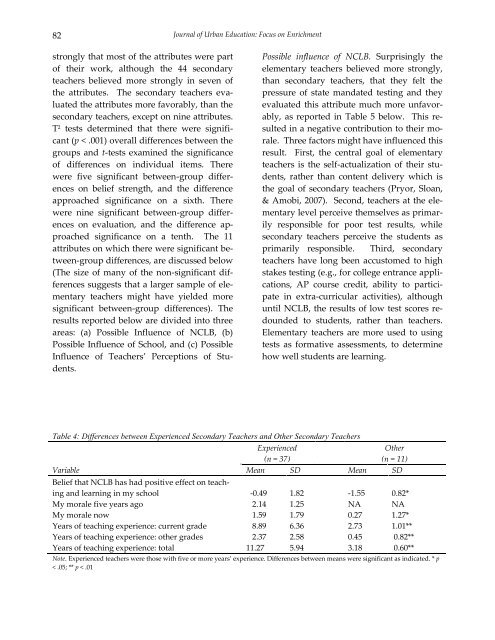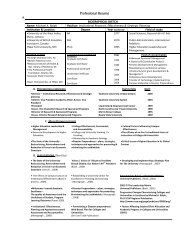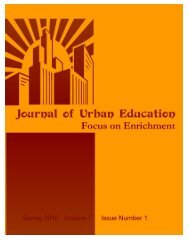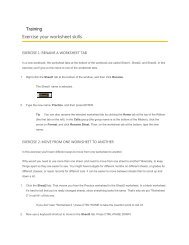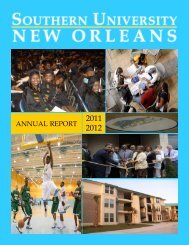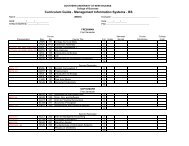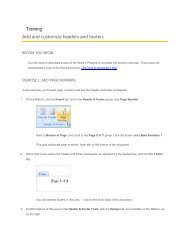Journal of - Southern University New Orleans
Journal of - Southern University New Orleans
Journal of - Southern University New Orleans
- No tags were found...
You also want an ePaper? Increase the reach of your titles
YUMPU automatically turns print PDFs into web optimized ePapers that Google loves.
82<strong>Journal</strong> <strong>of</strong> Urban Education: Focus on Enrichmentstrongly that most <strong>of</strong> the attributes were part<strong>of</strong> their work, although the 44 secondaryteachers believed more strongly in seven <strong>of</strong>the attributes. The secondary teachers evaluatedthe attributes more favorably, than thesecondary teachers, except on nine attributes.T 2 tests determined that there were significant(p < .001) overall differences between thegroups and t-tests examined the significance<strong>of</strong> differences on individual items. Therewere five significant between-group differenceson belief strength, and the differenceapproached significance on a sixth. Therewere nine significant between-group differenceson evaluation, and the difference approachedsignificance on a tenth. The 11attributes on which there were significant between-groupdifferences, are discussed below(The size <strong>of</strong> many <strong>of</strong> the non-significant differencessuggests that a larger sample <strong>of</strong> elementaryteachers might have yielded moresignificant between-group differences). Theresults reported below are divided into threeareas: (a) Possible Influence <strong>of</strong> NCLB, (b)Possible Influence <strong>of</strong> School, and (c) PossibleInfluence <strong>of</strong> Teachers’ Perceptions <strong>of</strong> Students.Possible influence <strong>of</strong> NCLB. Surprisingly theelementary teachers believed more strongly,than secondary teachers, that they felt thepressure <strong>of</strong> state mandated testing and theyevaluated this attribute much more unfavorably,as reported in Table 5 below. This resultedin a negative contribution to their morale.Three factors might have influenced thisresult. First, the central goal <strong>of</strong> elementaryteachers is the self-actualization <strong>of</strong> their students,rather than content delivery which isthe goal <strong>of</strong> secondary teachers (Pryor, Sloan,& Amobi, 2007). Second, teachers at the elementarylevel perceive themselves as primarilyresponsible for poor test results, whilesecondary teachers perceive the students asprimarily responsible. Third, secondaryteachers have long been accustomed to highstakes testing (e.g., for college entrance applications,AP course credit, ability to participatein extra-curricular activities), althoughuntil NCLB, the results <strong>of</strong> low test scores redoundedto students, rather than teachers.Elementary teachers are more used to usingtests as formative assessments, to determinehow well students are learning.Table 4: Differences between Experienced Secondary Teachers and Other Secondary TeachersExperienced(n = 37)Other(n = 11)Variable Mean SD Mean SDBelief that NCLB has had positive effect on teachingand learning in my school -0.49 1.82 -1.55 0.82*My morale five years ago 2.14 1.25 NA NAMy morale now 1.59 1.79 0.27 1.27*Years <strong>of</strong> teaching experience: current grade 8.89 6.36 2.73 1.01**Years <strong>of</strong> teaching experience: other grades 2.37 2.58 0.45 0.82**Years <strong>of</strong> teaching experience: total 11.27 5.94 3.18 0.60**Note. Experienced teachers were those with five or more years’ experience. Differences between means were significant as indicated. * p< .05; ** p < .01


